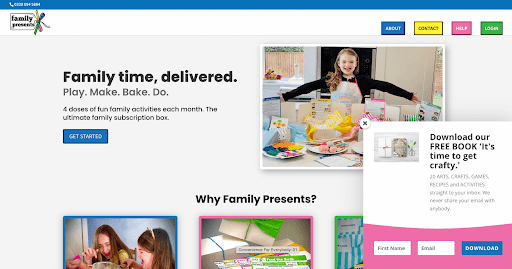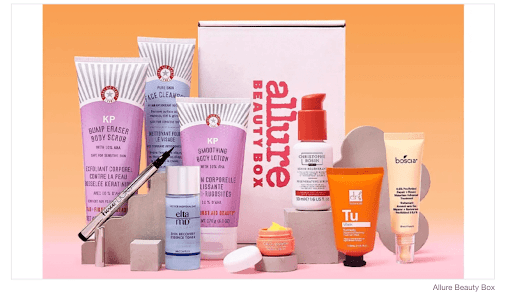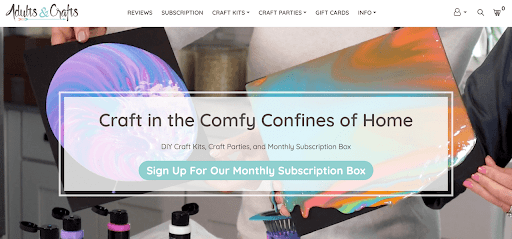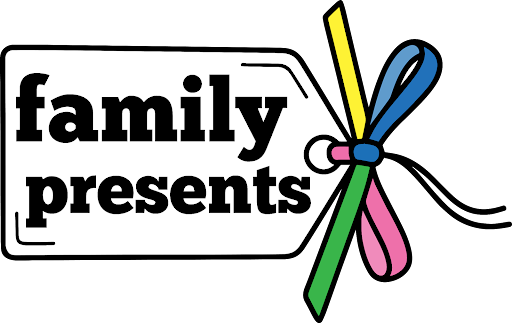So, you want to know how to start a subscription box?
A subscription box business isn’t on your typical list of business ideas. It certainly wasn’t on mine.
In 2020, I was running a popular Theatre School Franchise in the UK. My partner and I had built it to six figures, with a steady flow of new customers. In March of that year, the world closed. No business plan in the world could have foreseen that coming. Our cash flow went from “comfortable” to “nothing” in 24 hours.
After we’d finished panicking, it was time to quickly pivot to something different to save us from hunger and to keep up the payments on our house. I had no experience providing a subscription box service, but I knew quite a bit about running businesses, having started a few.
As we couldn’t leave the house, we started looking around for new products to entertain our children in the long days at home. There were a few subscription box ideas that were geared toward families, but nothing to write home about.
We started researching the business model, searching through social media, and looking at other business owners with their subscription box service. That’s how we founded Family Presents, a subscription box providing fun family activities.
In this article, I’ll talk discuss:
- What is a subscription box?
- Key benefits for ecommerce businesses and online stores
- What I learned from starting my subscription box business
- Is your business suited to starting a subscription box?
- How to start selling subscription boxes in 15 steps
What is A Subscription Box?
Behold the subscription box, a modern marvel of retail therapy that transforms your mailbox from a dreary den of bills and spam into a treasure chest of monthly surprises.
Imagine a magical loot crate that arrives on your doorstep, chock-full of themed goodies tailored to your unique interests and tastes. We're talking about a perfect blend of convenience, personalization, and unboxing excitement!
Subscription boxes are like having a birthday party every month, but with no age reminder to dampen the fun. Curated by experts with a flair for fabulous finds, these boxes are designed to cater to your passions, whether you're a fitness fanatic, a beauty buff, a foodie fiend, or a hobby hound.
In today's fast-paced, digital world, subscription boxes provide a tangible treat to brighten your day and give you something to look forward to.
The question is: Is it a viable business model? And more importantly: Should you introduce it into your ecommerce business?
My answer is a resounding yes on both counts.
5 Key Subscription Box Benefits
Here are five key benefits of introducing the subscription box model into your ecommerce business.
1. Customer retention
Introducing a subscription box to your ecommerce business can boost customer loyalty and retention. By offering a recurring, personalized experience, your customers are more likely to return and maintain an ongoing relationship with your brand.
2. Predictable revenue
Subscription boxes provide you with a steady stream of recurring income. This allows your business to forecast revenue more accurately and allocate resources efficiently, improving your financial stability and planning.
3. Increased product exposure
Subscription boxes are a great way for your ecommerce business to showcase new or lesser-known products to a wider audience. Including these items in a curated box makes customers more likely to discover and engage with your (previously unexplored) offerings.
4. Enhanced brand image
By creating a subscription box, your business can position itself as an expert in your niche, curating high-quality products that resonate with your target audience. This can strengthen your brand's image, foster trust, and elevate the perceived value of your offerings.
5. Valuable customer insights
Subscription boxes offer an opportunity to collect data on your customers’ preferences, purchase patterns, and customer feedback. This information can be used to optimize product selection, marketing strategies, and even future product development, ensuring that the business stays in tune with its audience's needs and desires.
What I Learned From Starting My Subscription Box Business
Although we hadn’t worked using a subscription box business model, we are both parents, and any product that fulfills a need and saves time and money would be viable for the target audience.
Because the pandemic forced the entire world to sit at home, twiddling their thumbs, the idea of families regularly receiving a package that felt like a present arriving at the front door would appeal to parents.
There were likely to be enough loyal customers out there who would enjoy our idea and be willing to share their positive customer experience with like-minded parents.
So, if we wanted this to be potentially picked up by influencers and create a step-by-step guide to family time—how could we make the most of the opportunity with our subscription box?
Research
Rather than diving straight into our niche and thinking about profit margin and marketing strategies, we started by looking at some of the greats.
Dollar Shave Club was a good place to start, I remembered their marketing video from several years earlier, where they quickly took the world by storm. Even Richard Branson shared it. He was so impressed.
Obviously, it’s a completely different business model, but each month they send out new products to customers all over the globe.
I also contacted a guy who ran a subscription box called “Buster Box.” They’d been featured on the Irish version of Dragons’ Den, and he was keen to share some general tips and tricks about customer acquisition and the subscription box business model.
Their subscription products were for dog owners, so there was no conflict of interest, and he was very positive about our ideas and taught me a lot about how the monthly subscription model worked.
Prototyping the box
After a week’s intensive research (we were moving as quickly as possible, remember), we set to work and branded the company as quickly as we could.
We put the initial costs onto a credit card and held our breath as we created a prototype box.
We found a customer base willing to test the box and started amassing an email list to collect the details of leads and potential customers.
Choosing the types of products
Family Presents was always going to be a small business designed for families to do activities with one another.
We had four boxes inside a larger box: PLAY, MAKE, BAKE, and DO.
The idea was that the PLAY box would give families a game to play with each other.

The MAKE box would be a crafty activity to suit children and adults—again, encouraging parents to spend time being creative with their children.

The BAKE box provided a cacophony of dry ingredients for baking: bread, cakes, and biscuits—we trialed it all.

The DO box had links to the outdoors: One month, families created a wind chime, and another, they created a bird feeder.

We wanted the unboxing experience to be like opening a present for the entire family, so we worked hard in the pre-launch to make it look as much like a present as possible. We used bows made out of crepe paper. As a new business, we had to wrap each box individually.
The premise worked brilliantly, but the execution of it was not so easy.
Problems and solutions
I’m guessing you want to hear about the good bits? I’ll explain all of those when outlining how you can set up your own subscription box business later on.
For now, let’s talk about the pitfalls and solutions I found from having no experience in the subscription box market.
Problem #1: Component sourcing was tricky
Our boxes contained many ingredients and components that were often difficult to source. We turned to Pinterest for a lot of our art and craft ideas.
What we had chosen was not just assembling products from various sources and sending them out to new customers every month.
As startups tend to tell you, we were doing the job of several teams of people.
It was wonderful having 100 new subscriptions in Month 2, but that meant designing and then filling 500 boxes with materials (four boxes in each, remember).
There were many late nights and lots of tears.
Problem #2: Shipping costs caused problems
We opted to factor in the cost of shipping into our subscription products and absorbed the loss ourselves. This hit our profit margin quite hard, and we had to increase the price of the box in month three to cover our overheads.
We did not make a profit until Month 4.
Problem #3: We had to grow an audience
It’s easy to think that social media influencers are unobtainable in the early days unless you have a bottomless money pit. This is not the case.
We targeted influencers with a fan base of 10,000 to 20,000 followers, and most of them liked our business model and were happy to share the contents of our boxes on their social media platforms in exchange for just a free box.
This was the most effective marketing we could’ve done as entrepreneurs, and it was worth investing the time in building relationships with them from day one.
Problem #4: Website design
While I had designed several websites before, I had never produced something of this scale, and I don’t do coding.
Previous websites were produced on WordPress, so we avoided Shopify and Amazon to maintain overall control and keep all of the profits.

So, did it work?
Ultimately, a subscription box only maintains its success when you keep adding new customers and can retain the current ones.
To continue growing at the rate we were would have required funding for premises and help to pack the boxes. At the height of the business, we were sending out 400 boxes per month. That might seem small, but remember that each box had four more boxes inside, individually wrapped and tied.
Each box sold for $30, making our turnover around $12,000 at our peak.
We grew quickly, thanks to some positive PR from a small influencer fan base. It was almost too fast for a small, family-run operation. This shows how far a good subscription box can travel in a relatively short time!
Is Your Type of Business Made For Subscription Box Success?
In a world where convenience is king and consumers crave personalized experiences, subscription boxes have emerged as the ultimate retail matchmaker.
This alluring ecommerce trend has taken the market by storm, leaving entrepreneurs wondering which businesses are best suited to embrace the subscription box model.
So, now that we’ve covered the basics—and you’ve heard my tale—let's dive into a selection of industries primed for subscription box stardom.
Health and fitness
Leisure enthusiasts and fitness fanatics rejoice!
Health and fitness-based subscription boxes are perfect for those who want to stay in shape, explore new workout routines, and discover the latest wellness products.
Businesses in this niche can curate boxes that include activewear, gym accessories, nutritional supplements, or even meal plans.
A monthly dose of motivation combined with personalized product selections? That's a recipe for subscription box success.
Beauty and grooming
The ever-evolving beauty and grooming market is ripe for subscription box treatment.
With a seemingly endless array of cosmetics, skincare, and grooming products, it can be overwhelming for consumers to navigate this industry.
Enter the beauty and grooming subscription box: a curated, personalized assortment of products that cater to each subscriber's unique preferences.
From makeup mavens to bearded gentlemen, there's a subscription box for everyone, making it an ideal fit for businesses in this sector.

Food and beverages
Foodies, unite! Subscription boxes in the food and beverage industry have opened the door to a world of culinary adventure.
For businesses specializing in artisanal products, gourmet ingredients, or exotic snacks, subscription boxes offer the perfect platform to showcase their delicious offerings.
These mouthwatering boxes can introduce subscribers to new flavors and regional specialties or teach them how to cook a meal from scratch.
Food and beverage businesses can truly make a lasting impression on their customers' taste buds (and hearts.)

Hobbies and crafts
The realm of hobbies and crafts is vast and varied, making it a prime candidate for subscription box success.
Businesses that cater to specific hobbies, such as knitting, painting, or model building, can curate boxes filled with tools, materials, and inspiration needed to fuel subscribers' creative pursuits.
For craft enthusiasts, the excitement of unboxing a new project each month is unrivaled, and businesses can capitalize on this enthusiasm by delivering a monthly dose of hands-on fun.

Personal development
Subscription boxes are an excellent way for businesses in the personal development space to make a lasting impact on their customers' lives.
Whether focusing on mental wellness, self-care, or professional growth, these boxes provide subscribers with the resources and motivation they need to evolve and thrive.
From self-help books to meditation aids, personal development subscription boxes offer a truly transformative experience that customers won't find anywhere else.
Need more inspiration? Here are 97 subscription box ideas that you could start today.
How To Start Selling Subscription Boxes In 15 Steps
As you can see, many businesses can find their feet with a subscription box offering, especially if they have the know-how.
It’s also much easier if you have loyal customers waiting in the wings who know your brand and have already enjoyed a positive customer experience.
Startups can enjoy doing it too, of course, but an existing business with a long email list and an ecommerce platform will have an easier time than starting from scratch.
Ready to build your subscription box for your brand? Here are 15 steps to get started.
Step 1: What’s your niche? And audience?
If your business already exists and you’re not starting completely from scratch, then you will likely know your audience.
Just remember, though—if a subscription box is going to be an add-on that piggybacks on your ecommerce business—that there’s a possibility this audience may differ from your existing customers, so you may need to carry out some additional research.
Market research
So, do you know your niche? That’s fine. Make sure there’s a market to fill the gap for monthly products.
If you’re already an ecommerce business, perhaps you could look for an area in your niche that does not currently have a subscription box.
If you haven’t identified your niche yet, don’t panic. Before diving in and getting immersed in creativity, it's crucial to conduct market research to identify an area with demand and potential for growth. Look for trends, emerging industries, or underserved markets to find the sweet spot for your subscription box.
Target audience
Once you've identified your niche, it's time to create a customer avatar. Who is your ideal customer? What are their interests, preferences, age range, and demographics?
Remember, your marketing strategy will completely change based on the age range of customers. It will also have an impact on your branding.
If you’re an established ecommerce brand, if your customer avatar is different from your usual customer base, you may want to create a separate division of the company to change the color, style, and branding of the subscription box.
Competition
I always love spying on the competition.
Stare at them deeply through the lens of Ahrefs, Moz, or another competitor tool to see how much traffic they’re getting to their website.
Become a customer, and order their physical product. What have they done well? Where can you be different?
You can use this information to position your subscription box in the marketplace and find differentials or things you can do better. How can you innovate and think outside the box with your product and marketing strategies?
If you regularly analyze your competition in your existing business, be sure to have a sneaky look and see whether your competitors are offering subscription boxes as part of their own business model.
Step 2: Choose the right subscription model
Recurring vs. prepaid subscriptions
Decide if you want a recurring subscription, where customers are billed monthly, or a prepaid model, where customers pay upfront for a set number of boxes.
Each option has pros and cons, so consider your target audience's preferences and your business's cash flow needs.
With Family Presents, we offered both options. There were far more sign-ups when we offered a monthly box at a slightly higher price because although the monthly cost was lower, so was the customer’s risk.
Prepaid subscriptions were usually bought as gifts for a birthday, at Easter, or Christmas—but that’s because our target market was predominantly parents and grandparents.
Curation vs. customization
Another decision you'll need to make relatively early (because of your website design) is whether to offer a curated box with a pre-selected assortment of items or a customized box where subscribers can choose specific items to include.
Curated boxes offer a surprise element and can be more manageable to source and pack. This is the model we used with Family Presents. We did field the odd email asking whether customers could choose what was in the boxes, but for the most part. People were happy to see previous boxes on our website to get an understanding of the type of content they would be receiving rather than needing to know exactly what was in each box.
Customized boxes cater to individual preferences and can increase customer satisfaction. However, it’s far more difficult to pack hundreds of boxes with different contents.
Step 3: Source products for your subscription box
Wholesale suppliers
Partnering with wholesale suppliers is a cost-effective way to stock your subscription box with quality products.
Reach out to manufacturers and distributors that align with your niche and audience to negotiate favorable pricing and ensure a steady supply of items.
As your box scales, your profit margin increases because bulk ordering means you can negotiate a far better price with potential suppliers—especially if you have an existing relationship with them.
Local and handmade products
Including local or handmade products can add a unique touch to your subscription box and help support small businesses.
Look for artisans or craftspeople in your community whose work fits your niche and target audience.
Collaborations with brands (and influencers)
Collaborating with household brands can help boost the appeal of your subscription box and provide marketing opportunities—especially if you can constantly update your website content.
When the time is right, reach out to brands and social media influencers within your niche to explore partnerships or exclusive products for your subscribers.
This is far easier to do if you have an existing customer base to entice them with, but it is possible to do as a startup. You just need to phrase your messages appropriately.
Make sure you research and contact everybody personally, with some knowledge of what they do, their area of expertise, or their level of influence.
I would recommend contacting social media influencers with a following between 8,000 and 20,000. Those with more followers tend to charge for sponsorship opportunities. Those with a smaller fan base usually offer publicity for the free product.
Step 4: Determine your pricing strategy
Cost of goods and shipping
Calculate the cost of goods, packaging, and shipping for each box.
You need to factor in every cost to determine whether your box will be profitable or realize how many months (based on your predicted growth) it will take to make a profit.
Full disclosure: I had accounted for Family Presents to be profitable from Month One. It took until Month Four, and this was because shipping costs far exceeded my initial estimations.
Do your research now. It’s better to know in advance that you won’t make a profit until month six if this is the case.
Profit margins
Determine your desired profit margins and set your pricing accordingly. This is a difficult balance because you must know it will be affordable for your target audience.
With some models, the numbers just don’t stack up. You can’t market a $59 per month box to a 21-year-old demographic, as most will not be able to afford it.
So, what can you do? Change the number of products inside the box? Make it a bi-monthly box instead and split the cost over two months? There are many options, but I cannot stress enough how important it is to work through all of this in advance.
Pricing tiers
Consider offering different pricing tiers or box sizes to accommodate various budgets and preferences. This approach can help attract a broader audience and encourage upsells.
Step 5: Design your subscription box
Packaging
Consider high-quality packaging that is both functional and visually appealing. Your box should protect the contents during shipping and create a memorable unboxing experience.
It is worth saying, as a business of the 21st Century (that I’m sure you are), it is worth considering the environment in all of this too. Customers love it when you are kind to Mother Nature.
With Family Presents, we were plastic-free from Day 1, and it provided us with a great marketing angle: ”All the Crafts You Need with No Waste. And No Plastic.”
Branding
Incorporate your logo, colors, and other branding elements into your box design to reinforce your brand identity and create a cohesive customer experience.
Top tip: Invest some time into making your logo stand out. We went through several designs with Family Presents but eventually landed on something that brought us a lot of customers.

Unboxing experience
Add personalized touches, like handwritten notes or free samples, to enhance the unboxing experience and make your subscribers feel valued.
We included a letter in the Family Presents box each month with a little update about our family because it worked specifically for our target audience. I’m not suggesting you do that, but it didn’t encourage social shares and word-of-mouth marketing.
Step 6: Set up your ecommerce platform
Website
Build a user-friendly website that showcases your subscription box and provides essential information about your products, pricing, and shipping. Make sure your site is mobile-responsive and optimized for search engines.
In this world of competitive search, there’s no getting away from the fact that you should give some focus to SEO.
Payment gateways
Choose a user-friendly payment gateway that supports recurring billing and allows for secure transactions on your website. Make sure it integrates with your ecommerce platform.
Frankly, Stripe or PayPal offer the smoothest checkout experience for your customers. You can also consider a service like Subbly, which can provide a payment gateway integrated with a customer relationship management system (CRM) and makes managing your box slightly easier.
Subscriber management
The easier, the better.
There are plenty of subscription management solutions for ecommerce sellers. We used Subbly (spoken about above) for Family Presents as it was relatively intuitive and linked well with our website.
However, Pipedrive, which I’ve used for other projects, is a simple and easy-to-use CRM for customers.
Step 7: Create a marketing strategy
Social media
Jump on social media and start spreading the word about your subscription box, especially if you have a following.
We got a fair amount of traction from showing off some "behind-the-scenes" stuff—customers loved watching us create the boxes, and because it was a family business, everybody was involved!
You can also encourage people to share short unboxing videos, which tended to work very well for us on Instagram.
Influencer marketing
Ensure you are working with influencers with a similar audience to your subscription box. It’s no good sharing your box with somebody with a completely different demographic, even if they had a billion subscribers—5,000 targeted followers is far more effective.
Email marketing
Start an email list to keep people updated on new products, special deals, and news about your business. Use email blasts to turn potential customers into actual ones.
Step 8: Launch your subscription box
When you've got everything ready, it's time to launch your subscription box. Use social media, email, and influencer connections to spread the word. You could even offer special deals to get people signing up early.
Step 9: Focus on customer retention
Customer service
Make sure you're there to answer any questions or problems quickly. Good customer service will keep people returning and get them talking about you.
Research suggests that being contactable by phone increases conversions, and we put the phone number at the top of our website as a virtual landline routed to our mobile so that people could get in touch with us whenever they wanted.
Special offers and loyalty programs
Consider offering deals, discounts, or loyalty programs to thank your regular customers and make them want to stay. Exclusive perks can make your customers feel special and less likely to cancel.
Top tip: The turnover of customers in the subscription box world is known as its “customer churn rate.”
Step 10: Analyze and optimize your subscription box
Keep an eye on how your subscription box is doing, including what customers think, how many people are canceling, and how much you're selling. Use this info to improve your product, prices, and overall marketing strategy.
Step 11: Scale your business
If your subscription box is going well, consider expanding your product range, targeting new customers, or offering add-on products to increase overall revenue.
Scaling your business may also require hiring additional staff, automating processes—potentially with AI, or upgrading your ecommerce platform.
Who knows, you might even get to the stage where your subscription box is outselling the other products on your ecommerce site and may want to pivot entirely!
Step 12: Stay engaged with your community
Stay connected with your customers and people who are into the same stuff as you through social media, emails, and events. Regular contact makes people feel part of your brand and keeps you in their thoughts.
Step 13: Keep innovating
Keep up-to-date with industry trends and customer preferences to ensure your subscription box remains relevant and appealing.
Experiment with new products, packaging, or marketing tactics to keep your offering fresh and exciting.
Step 14: Learn from your competitors
Keep an eye on your competitors and learn from their successes and failures. This insight can help you identify opportunities for growth and improvement.
Step 15: Stay committed to your business
Starting and growing a subscription box business takes time, effort, and determination. Stick with it, stay focused on your goals, and be ready to change things if needed.
Starting A Subscription Box Business Is Rewarding
Starting a subscription box business is fun.
I also learned the most I’ve ever learned about innovation and customer satisfaction through trying and testing this business model. Each monthly box is born from your idea—an extension of hours of planning, negotiating, packing, repackaging, marketing, and selling.
If you can dedicate yourself and part of your business to your subscription box consistently, there is something really exciting about a little piece of you being delivered to your customers each month.
If you want more tips on building a successful ecommerce business, subscribe to The Ecomm Manager newsletter today.
More great ECM content:
- What Is Subscription Ecommerce: Examples, How To Set Up & Top Platforms
- Ecommerce Loyalty Programs: Types, Examples & Tools To Get Started
- The Best Types of Ecommerce Packaging: A Complete Guide
- 7 Examples Of Sustainable Ecommerce Packaging & Eco-Friendly Materials
- An Easy Guide To Ecommerce Shipping
- How To Offer Free Shipping On Your Ecommerce Store: Examples & Solutions
- Ecommerce Shipment Tracking: How To Use Order Tracking To Boost Your Sales
- 10 Best Subscription Ecommerce Platforms
- 10 Best Sustainable Packaging Manufacturers
- 10 Best Ecommerce Shipping Companies For Ecommerce Sellers



